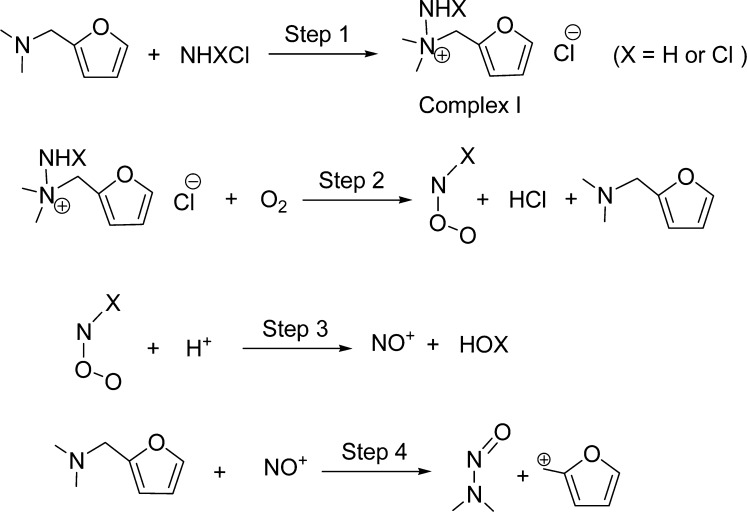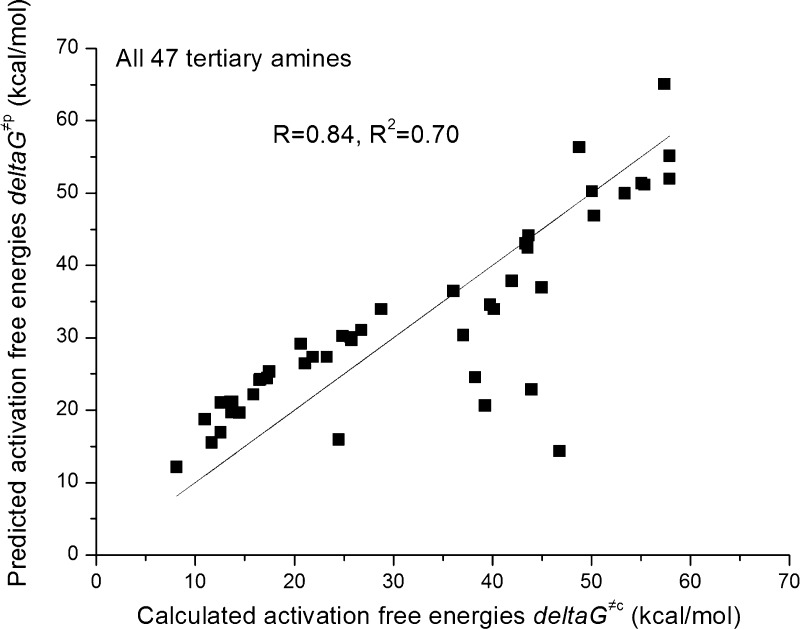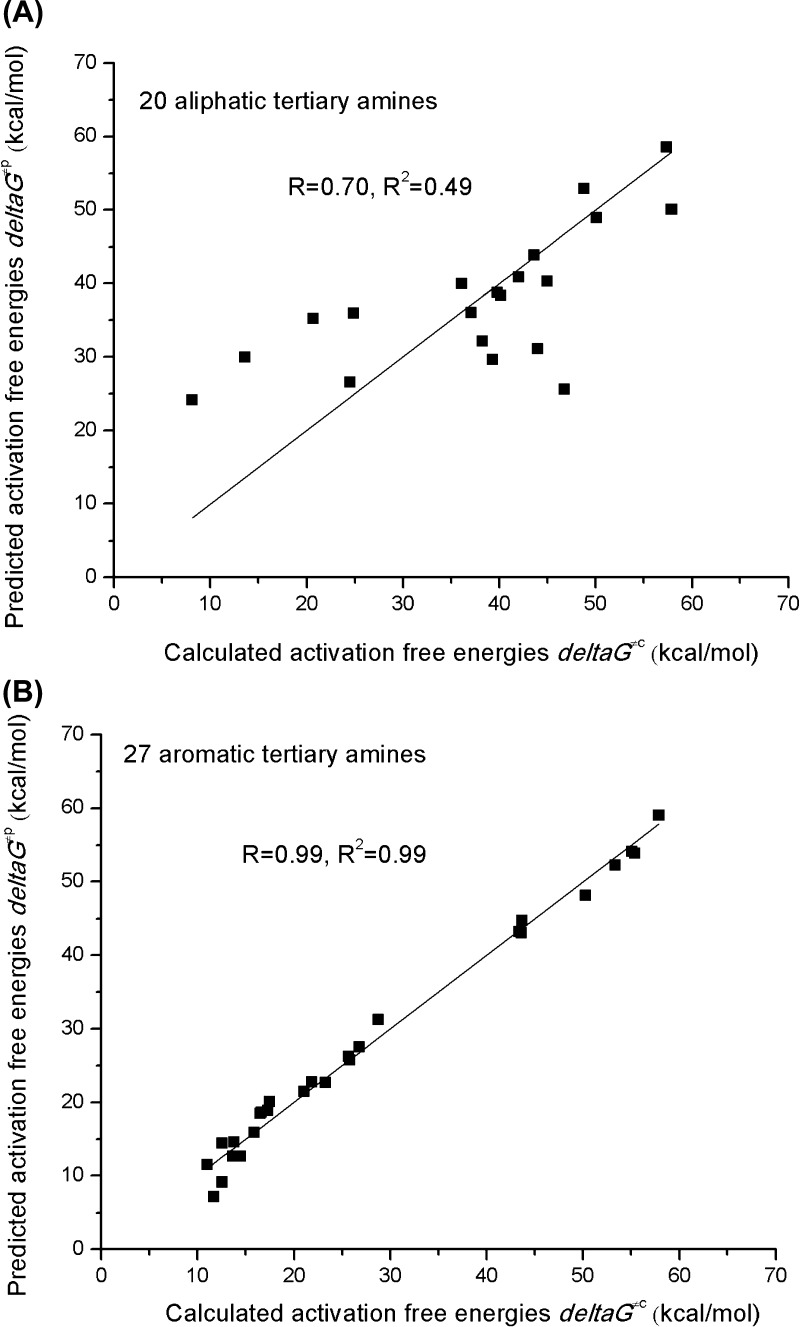Abstract

Chloramination of drinking waters has been associated with N-nitrosodimethylamine (NDMA) formation as a disinfection byproduct. NDMA is classified as a probable carcinogen and thus its formation during chloramination has recently become the focus of considerable research interest. In this study, the formation mechanisms of NDMA from ranitidine and trimethylamine (TMA), as models of tertiary amines, during chloramination were investigated by using density functional theory (DFT). A new four-step formation pathway of NDMA was proposed involving nucleophilic substitution by chloramine, oxidation, and dehydration followed by nitrosation. The results suggested that nitrosation reaction is the rate-limiting step and determines the NDMA yield for tertiary amines. When 45 other tertiary amines were examined, the proposed mechanism was found to be more applicable to aromatic tertiary amines, and there may be still some additional factors or pathways that need to be considered for aliphatic tertiary amines. The heterolytic ONN(Me)2–R+ bond dissociation energy to release NDMA and carbocation R+ was found to be a criterion for evaluating the reactivity of aromatic tertiary amines. A structure–activity study indicates that tertiary amines with benzyl, aromatic heterocyclic ring, and diene-substituted methenyl adjacent to the DMA moiety are potentially significant NDMA precursors. The findings of this study are helpful for understanding NDMA formation mechanism and predicting NDMA yield of a precursor.
■. Introduction
In drinking water disinfection, chloramination can significantly reduce the formation of regulated disinfection byproducts (DBPs), such as trihalomethanes and haloacetic acids formed during chlorination. Unfortunately, chloramination has been associated with the formation of N-nitrosamines.1−10 Over the past decade, there has been great interest in the investigation of N-nitrosamines formation in drinking water treatment because many of them are carcinogenic, mutagenic, and teratogenic.1−20 In particular, N-nitrosodimethylamine (NDMA), which has the simplest structure and is the most commonly detected N-nitrosamine, has been demonstrated to be a potent carcinogen.21−23 In the Integrated Risk Information Service (IRIS) database of the United States Environmental Protection Agency (U. S. EPA), NDMA has been identified to have an estimated 10–6 lifetime cancer risk level at a concentration of 0.7 ng/L in drinking water.24 Although there are currently no federal regulations for nitrosamines in drinking water in the United States, the U. S. EPA has recently identified nitrosamines as one of three potential groups of contaminants highlighted for future regulation.25
To date, several N-nitrosamine formation mechanisms have been proposed especially for NDMA.4,7,8,12−14,26 Generally, there are two main pathways, that is, nitrosation and UDMH mechanisms. With respect to the nitrosation,26−33 reactions between amines and nitrosating agents (such as NO+, nitrous acid, and some reactive nitrogen oxide species) leads to formation of N-nitrosamines. The classic nitrosation mechanism usually involves nitrite, which participates the formation of nitrosating agent in the acidic solution26−28 or in the presence of hypochlorite (HOCl),29,30 carbonyl compounds,15,31,32 or sunlight.33 The formation of N-nitrosamines during oxidation of amines mediated by ozone or potassium permanganate are other nitrosation pathways,34−36 in which the nitrosating agent is generated from the oxidation of amines. The UDMH mechanism12−15 was proposed to explain NDMA formation during chloramination of dimethylamine (DMA), in which a nucleophilic substitution reaction between DMA and chloramine (NH2Cl or NHCl2) leads to formation of an unsymmetrical dimethylhydrazine (UDMH) or chlorinated UDMH intermediate (UDMH-Cl), and then the intermediate is oxidized by dissolved oxygen to produce NDMA. However, further studies have shown that chloramination of UDMH yielded much less NDMA than DMA.19 In addition, the presence of dichloramine has been shown to enhance NDMA formation from DMA through the formation of a chlorinated UDMH.19 Regardless of the intermediates, some tertiary amines (such as ranitidine and N,N-dimethylbenzylamine) have much higher NDMA yields (i.e., >60%) as compared with DMA or UDMH (i.e., <3%).1−4,9,10,19,37 In order to explain the high formation yield of NDMA from ranitidine during chloramination, Le Roux et al.4 hypothesized that a methylfuran moiety of ranitidine undergoes decomposition to generate a carbocation by identifying several intermediates using HPLC-MS technique. More recently, Selbes et al.9 investigated 20 tertiary amines in chloramination process and observed that the stability and electron distribution of the leaving group of tertiary amines play an important role in NDMA formation. However, so far, the formation mechanism of NDMA from tertiary amines during chloramination has not been fully understood. Questions on how the oxidation reaction by dissolved oxygen proceeds, why some tertiary amines have rather high NDMA yields, and what kind of relationship is between structure and reactivity of tertiary amines have not been elucidated yet.
To address the above questions, herein, we report our research on the formation mechanism of NDMA from ranitidine, trimethylamine (TMA), and 45 other tertiary amines during chloramination. A complete NDMA formation mechanism was proposed to explain remarkably different yields of various tertiary amines and structure–activity relationship of tertiary amines was obtained to predict more potent NDMA precursors. Also, four amines were selected to compare structure–activity with the DFT calculations. The results are expected to expand our understanding of NDMA formation mechanism(s) and its precursors and predict NDMA formation from different tertiary amine structures.
■. Theoretical Methods
Density functional theory (DFT) calculations were performed by using the B3LYP method (Becke’s three-parameter functional38 with the correlation functional of Lee, Yang, and Parr39) in conjunction with the 6-311G(d) basis set. In the proposed pathway, all structures of the reactants, transition states, and products involved in the formation reactions of NDMA during chloramination of ranitidine and various other tertiary amines were fully optimized. Vibrational frequencies were calculated at the same level of theory to characterize the nature of the stationary points. The minimum-energy path (MEP) was obtained using intrinsic reaction coordinate (IRC) calculations40 to confirm the connection of each transition state with the designated isomers. The solvent effect of water on the reactions of NDMA formation from ranitidine and trimethylamine during chloramination was also studied. The optimization and frequency calculations were first performed with the polarizable continuum model (PCM)41 at the B3LYP/6-311+G(d,p) level; however, some transition states of steps 2, 3, and 4′ have not been found. Therefore, instead the solvation free energy corrections were performed with PCM at the B3LYP/6-311+G(d,p) level. According to the results from Takano and Houk,42 UAKS cavity was selected. All computations were carried out with the GAUSSIAN-03 program package.43 The structure–activity relationship analysis was performed by the statistical software SPSS 11.5 version.44
■. Materials and Methods
A set of experiments were conducted to compare DFT calculations and NDMA formation from selected precursors. NDMA formation potential experiments were conducted on four amines that have not been reported in the literature. N,N,N′,N′-Tetramethyldiaminomethane (Methane-TMDA), N,N,N′,N′-Tetramethylethylenediamine (Ethane-TMDA), N,N,N′,N′-Tetramethyl-1,3-propanediamine (Propane-TMDA), and N,N,N′,N′-Tetramethyl-1,6-hexanediamine (Hexane-TMDA) were selected for testing based on their distinct differences of DFT results. The details of experiments can be found in the Supporting Information, Text SI-1.
■. Results and Discussion
NDMA Formation Pathways from Ranitidine during Chloramination
On the basis of the findings reported in the literature,4,9,14,19 NDMA formation is well established to be initiated by nucleophilic substitution. A recent study conducted by Le Roux et al.4 has identified some of the intermediates and the generation of a carbocation. These findings have been used to postulate the potential reactants and products and their associated intermediates to yield the identified structures in Le Roux et al.’s study. Each proposed reaction was evaluated using DFT models to evaluate if they are thermodynamically favorable or not. To simplify the DFT calculations, dimethyl-aminomethyl furan (R-Model) was used as the model compound (Scheme 1). After evaluation of a series of reaction, the proposed complete pathway was developed, which is provided in Scheme 2. Because monochloramine (NH2Cl) and dichloramine (NHCl2) coexist during chloramination process, the formation pathways of NDMA from reactions of R-Model with both chloramine species (NHXCl, X = H or Cl) were investigated side-by-side. Because of the similar structures of reactants, transition states, and products for both monochloramine (NH2Cl) and dichloramine (NHCl2), but only monochloramine’s reaction for each step are given in Supporting Information Figures SI-1–SI-3. The activation free energies and reaction energies (at 298 K and 1 atm) for each step of the NDMA formation pathway during chloramination of R-Model are given in Table 1.
Scheme 1. Chemical Structures of Ranitidine and Its Model, R-Model.

Scheme 2. Proposed NDMA Formation Pathways from Ranitidine Model during Chloramination.
Table 1. Activation Free Energies and Reaction Energies# Calculated at the B3LYP/6-311G* Level for Each Formation Pathways of NDMA from Ranitidine Model during Chloramination.
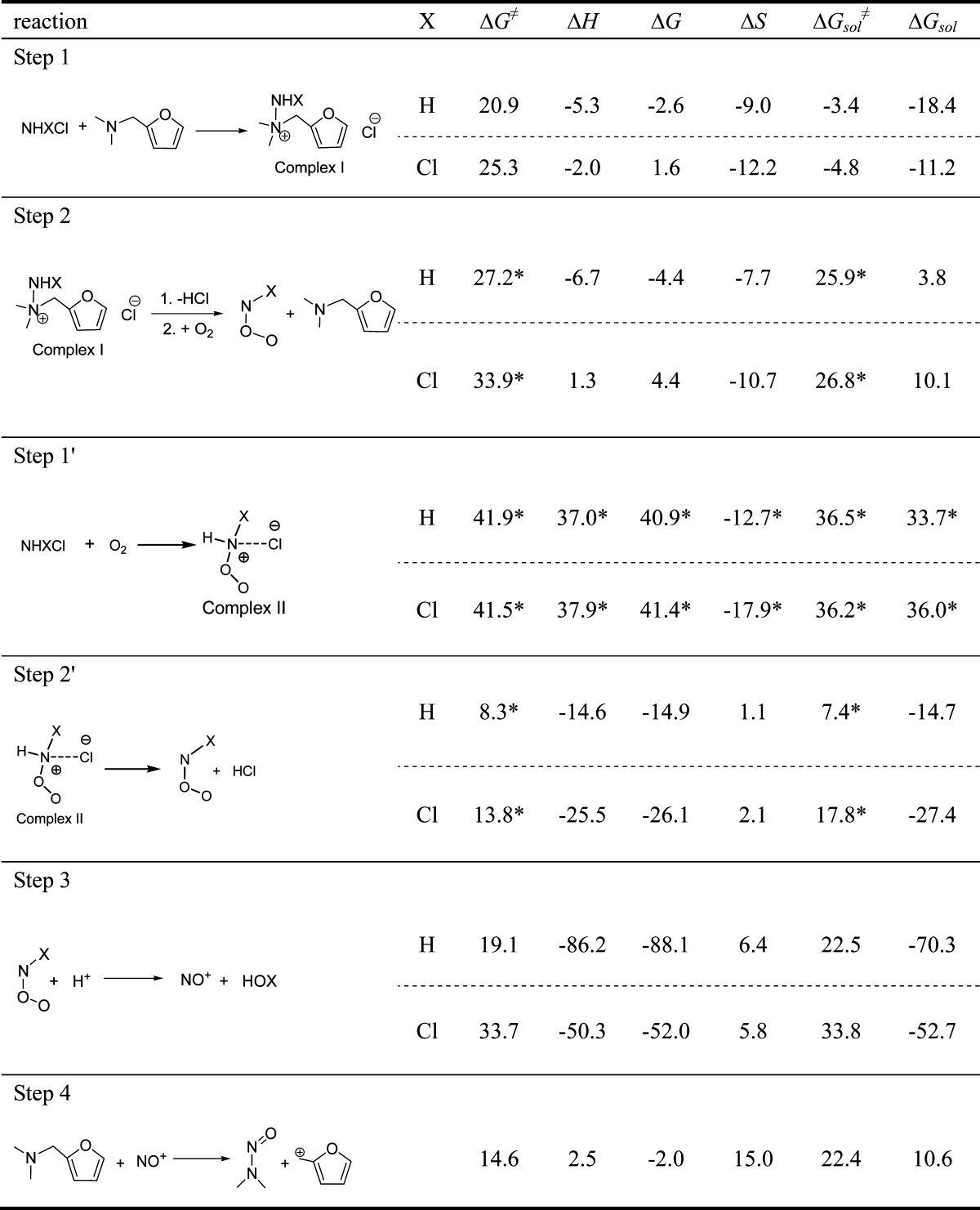
At 298 K and 1 atm, in kcal/mol except for ΔS, which is in cal/mol·K.
Values were calculated in the triplet states (for details, see Supporting Information).
As shown in Scheme 2, the formation of NDMA during chloramination of R-Model undergoes a four-step pathway. The first step, as proposed previously,12−15 involves a nucleophilic substitution reaction between NHXCl (X = H or Cl) and R-Model and produces a Complex I. The activation free energies (ΔG⧧) in the gas phase of this step for NH2Cl and NHCl2 are 20.9 and 25.3 kcal/mol, respectively, whereas those in water are negative values (Table 1), which means that these reactions occur easily in water. The enthalpy changes of reaction (ΔH) in the gas phase for NH2Cl and NHCl2 are −5.3 and −2.0 kcal/mol, respectively. It indicates that the nucleophilic substitution by NH2Cl and NHCl2 are both feasible in the gas phase and water, and the values of ΔG⧧ and ΔG for NH2Cl and NHCl2 are very similar to a difference less than 5 kcal/mol.
In the second step, an elimination reaction of hydrogen chloride from Complex I (X = H or Cl) first occurs and simultaneously forms an active intermediate [XN-R-Model], which is then easily trapped by oxygen molecule. With the oxygen approaching the nitrogen atom of NX moiety, an N–O bond forms and N–N bond cleaves, and then produces a nitrosating agent OONX as well as R-Model again. The calculation details of this reaction can be found in Supporting Information Text SI-2. Similar to the chloramination process, the activation free energies of the oxidation reactions for X = H and Cl are in the range of 25–34 kcal/mol. The enthalpy changes of reactions (ΔH) for X = H and Cl are −6.7 and 1.3 kcal/mol, respectively. It indicates that these reactions are thermodynamically feasible. As it is known that dissolved oxygen is a weaker oxidant than NHXCl (X = H or Cl), thus, it suggests that Complex I is active and render the reaction with dissolved oxygen to occur. This implies that the amine acts as a catalyst in Steps 1 and 2 to promote the oxidation of NHXCl to OONX. Moreover, imine peroxide (OONH) was first detected by Laursen et al.45 and they have shown that the activation energy of OONH is very small during the reaction of O2 with NH. Their study also supports that these proposed reactions are feasible; however, based on the DFT models, the oxidation process in Step 2 is harder to occur than the chloramination in Step 1 especially in water.
For comparison, the direct reaction of NHXCl (X = H or Cl) with dissolved oxygen without any catalysts was also explored. A two-step reaction for the direct oxidation was observed, in which Complex II forms in Step 1′ and then OONX and HCl release from Step 2′. As shown in Table 1, Step 1′ is the rate-limiting process of this reaction in both the gas phase and water. The free energy changes of reaction (ΔG) in Step 1′ are all above 30 kcal/mol in both the gas phase and water, whereas the reaction with catalyst (Steps 1 and 2) has ΔG in the range of −4 to 4 kcal/mol. It indicates that the direct oxidation reactions between NHXCl (X = H or Cl) and dissolved oxygen without any catalysts seem thermodynamically unfavorable in both the gas phase and water. Moreover, the activation free energies for this reaction are also relatively high with values above 36 kcal/mol, which are higher than those of Steps 1 and 2 by ∼10 kcal/mol. Thus, Steps 1 and 2 are essential for the formation of nitrosating agents both thermodynamically and kinetically.
In the third step, OONX (X = H or Cl) traps a proton and then dehydrates to generate a NO+ cation (Scheme 2). This step is a highly exothermic process in both the gas phase and water with the values of 86.2 (70.3) and 50.3 (52.7) kcal/mol for OONH and OONCl, respectively. The activation free energies for them in the gas phase are 19.1 and 33.7 kcal/mol, respectively, whereas those in water are 22.5 and 33.8 kcal/mol, respectively. Obviously, OONH has a much lower activation free energy than OONCl by around 10–15 kcal/mol, which implies that the ΔG⧧ of reaction involving NH2Cl is substantially lower than that for reaction involving NHCl2. Therefore, it can be concluded that monochloramine (NH2Cl) is preferable to dichloramine (NHCl2) in generating NO+. This agrees well with the present observations3,9 that monochloramine rather than dichloramine is responsible for NDMA formation from ranitidine.
NO+ is a well-known active nitrosating agent, and immediately after its formation, NO+ can react with the amine. The activation free energy in the gas phase of the last step (Step 4) is only 14.6 kcal/mol, whereas that in water is 22.4 kcal/mol. NDMA and a stable furan-2-ylmethanlium cation are released from the reaction of R-Model with NO+ cation, and the latter is prone to react with nucleophiles to form alcohols. These results are in good agreement with the mechanism proposed by Le Roux et al.4 based on their HPLC–MS results.
Comparison of Ranitidine and Trimethylamine (TMA) in NDMA Formation during Chloramination
For comparison, TMA was selected to represent a general acyclic tertiary amine, and the reactions between TMA and NHXCl (X = H or Cl) were investigated. The activation free energies and reaction energies (at 298 K and 1 atm) for each step of the NDMA formation pathway from TMA during chloramination are listed in Table 2.
Table 2. Activation Free Energies and Reaction Energies# Calculated at the B3LYP/6-311G* Level for Each Formation Pathways of NDMA from Trimethylamine during Chloramination.
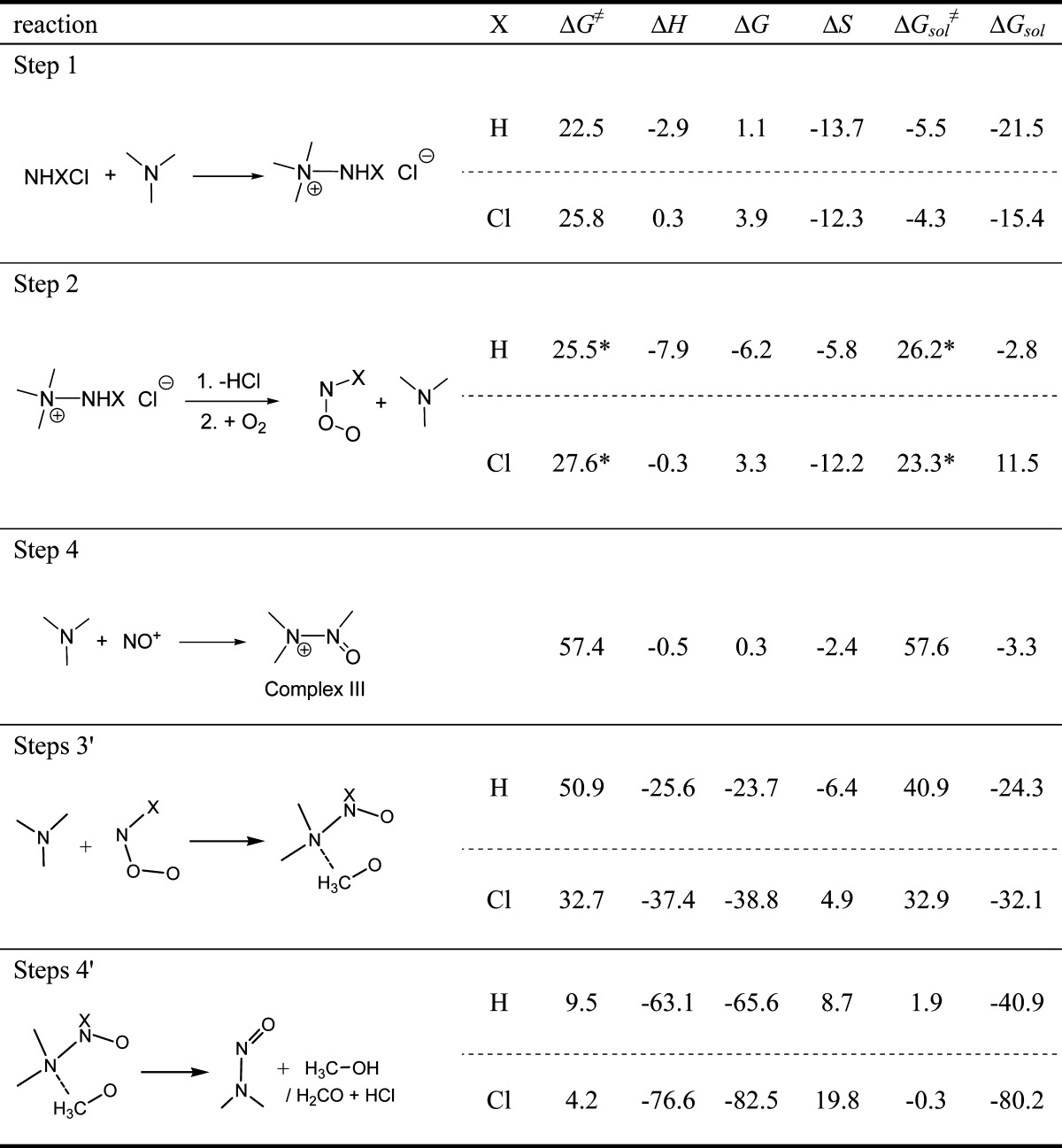
At 298 K and 1 atm, in kcal/mol except for ΔS, which is in cal/mol·K.
Values were calculated in triplet states (details see Supporting Information).
As shown in Table 2 in Steps 1 and 2, TMA has a similar activation free energy to the corresponding R-Model’s step. However, in Step 4, the ΔG⧧ of TMA is much higher than that of R-Model by around 43 and 35 kcal/mol in the gas phase and water, respectively. Such a notable difference in the activation free energy can explain the experimental results1−4,9,10,19,37 that the yield of NDMA from ranitidine is much higher (>60%) than that from TMA (∼2%), and only Step 4 was found to correlate to NDMA formation. Further studies demonstrated that this can be also attributed to the different stabilities of furan-2-ylmethylium and methylium cations. Selbes et al.9 has shown that stabilities of the leaving groups of tertiary amines play an important role in NDMA formation. Moreover, in the case of TMA, Complex III rather than NDMA ultimately forms, in which the methylium cation associates with the nitrogen atom of the NO moiety in NDMA. This is also due to the unstability of methylium cation. Therefore, it can be concluded that Step 4 is a key step for different tertiary amines and the stability of the carbocation generated in Step 4 plays a significant role in NDMA formation.
As discussed above, it seems that TMA is not as feasible as ranitidine to be nitrosated by NO+ because of the unstability of methylium cation. However, Liu et al. reported46 that compounds with ON-X structure are all potential nitrosating agents like NO+; thus, in this case, OONX (X = H or Cl) is likely to be the one. Therefore, the nitrosation reactions of TMA by OONX were also investigated and a two-step procedure was found as shown Steps 3′ and 4′ in Table 2. A nucleophilic substitution by OONX and an oxygen atom transfer are involved in Step 3′. In Step 4′, the hydrogen atom attached to N atom, for OONH system, is trapped by oxygen atom, which transferred to the carbon atom and produces methanol, whereas the chlorine atom, for OONCl system, combines with a hydrogen atom of H3C–O moiety and finally forms formaldehyde and hydrochloric acid. It is clear that Step 3′ is the rate-limiting step based on the data from the gas phase, whose activation free energies are 50.9 and 32.7 kcal/mol for OONH and OONCl, respectively, whereas those are 9.5 and 4.2 kcal/mol in Step 4′. Moreover, in Step 3′, OONCl system has a lower activation free energy than OONH in both the gas phase and water. Therefore, it can be concluded that dichloramine (NHCl2) is preferable to monochloramine (NH2Cl) in the nitrosation of TMA by OONX. This agrees well with the observations9,16,19 that dichloramine is responsible for NDMA formation from TMA.
Chloramination of Three Pharmaceuticals and Their Models
Three pharmaceuticals containing the DMA moiety, that is, ranitidine, doxylamine, and chlorphenamine, have recently caused much concern because they are potent NDMA precursors. Here, to simplify the calculation, the moieties far away from the DMA subunit of pharmaceuticals were replaced by a hydrogen atom as model compounds as shown in Table 3. Because Step 4 plays a significant role in NDMA formation, only the activation free energies of this step for ranitidine, doxylamine, and chlorphenamine were compared with their corresponding models. The results showed that the activation free energies for the models are nearly the same as those for pharmaceuticals with the difference of 1 to 4 kcal/mol. This suggests that the model simulated by replacing the moiety far away from the DMA group by hydrogen atom is reasonable and reliable to represent a large tertiary amine molecule.
Table 3. Activation Free Energies# Calculated at the B3LYP/6-311G* Level in the Gas Phase of the Key Step* for NDMA Formation from the Nitrosation of Three Pharmaceuticals and Their Models by NO+ Cation.
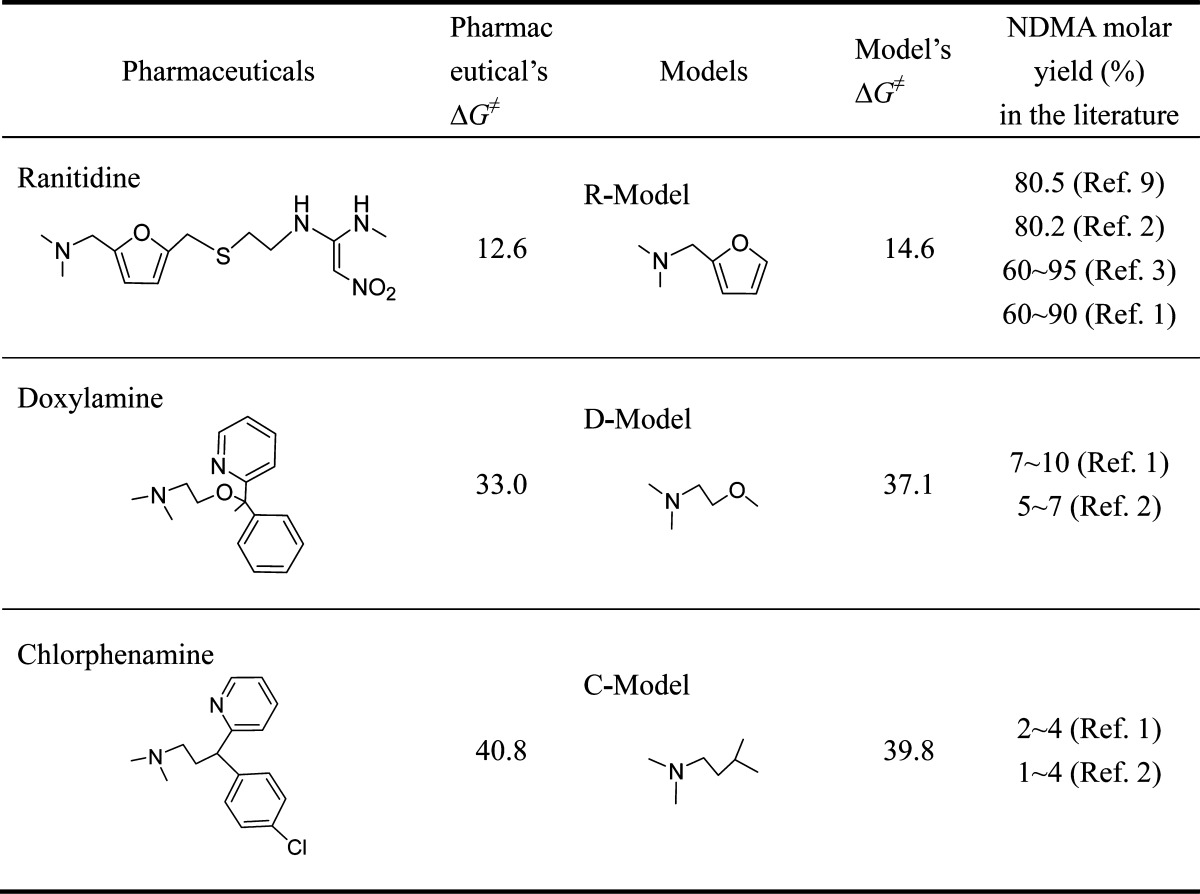
At 298 K and 1 atm, in kcal/mol.
Step 4.
The activation free energies for ranitidine, doxylamine, and chlorphenamine are 12.6, 33.0, and 40.8 kcal/mol, respectively. Thus, the activation free energy for ranitidine is much lower than those for doxylamine and chlorphenamine by around 20 and 28 kcal/mol, whereas doxylamine is lower than chlorphenamine by around 8 kcal/mol. Therefore, ranitidine has definitely much higher reactivity than doxylamine and chlorphenamine, whereas doxylamine is somewhat higher than chlorphenamine. These results agree well with the values reported in the literature1−3,9 that NDMA yields from ranitidine, doxylamine, and chlorphenamine are around 60–95%, 5–7%, and 2–4%, respectively.
Reactivities of Various Tertiary Amines in NDMA Formation during Chloramination
On the basis of the above results, it can be concluded that the nitrosating step, namely Step 4, is the key process for various tertiary amines, and it can be inferred that tertiary amines that can generate stable carbocations prefer this reaction. To verify these findings, to quantify the stability of a carbocation, and to understand structure–activity relationship, 45 additional tertiary amines with various functional groups attached to DMA moiety were selected. The activation free energies and reaction energies in the nitrosation of those tertiary amines by NO+ (in Step 4) are listed in Table 4. Additionally, the above discussions also show that Step 2 is a rate-limiting step for the important OONH formation. Thus, the reactions of Complex I with oxygen for all the amines were investigated and the results are listed in Supporting Information Table SI-1. Calculation results indicate that the activation free energies for most of the amines are in the range of 23–28 kcal/mol, and it means that the presence of a catalyst such as an aromatic tertiary amine does not make the formation of OONH more favorable.
Table 4. Activation Free Energies and Reaction Energies of Step 4c and Heterolytic ONN(Me)2–R+ Bond Dissociation Energies (HEBDE) to Release NDMA and Carbocations R+ Calculated at the B3LYP/6-311G* Level in the Gas Phase As Well As NDMA Molar Yields of These Tertiary Amines from Selbes et al.9.
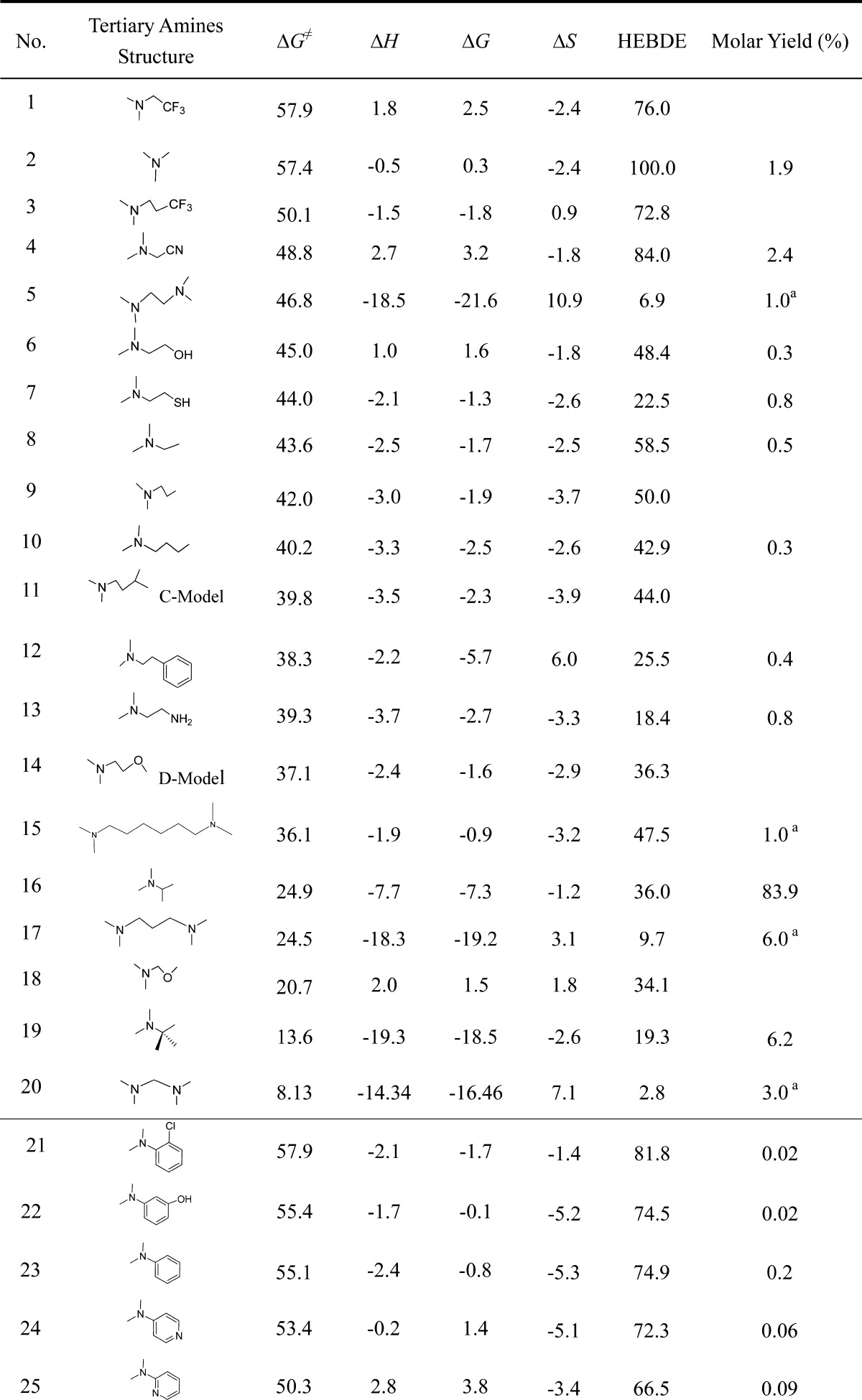

The NDMA yields of were found experimentally in this study.
The yield of ranitidine was reported for the R-Model.
At 298 K and 1 atm, in kcal/mol except for ΔS, which is in cal/mol·K.
According to the different functional groups attached to the DMA moiety, 47 tertiary amines (including TMA, D-, C-, and R-Model) were divided into two groups. Group I, the aliphatic group, is composed of aliphatic side-chain labeled from 1 to 20 as shown in Table 4, whereas Group II, the aromatic group, is composed of benzene rings, aromatic heterocyclic rings, or dienes labeled from 21 to 47. In each group, a remarkable difference in the activation free energies for various tertiary amines was noted with the values in ranging from 10 to 60 kcal/mol. Generally, for both groups, it can be found that the compounds with high activation free energies (ΔG⧧, the third column of Table 4) (>35 kcal/mol) have shown relatively low molar yields of NDMA (the last column of Table 4) (<1%). On the other hand, compounds with low activation free energies (<25 kcal/mol) have shown relatively high NDMA formation (>3%). As shown in Table 4, this trend is much more suitable for aromatic tertiary amines (Group II) than aliphatic tertiary amines (Group I), in which the activation free energies for compounds 21-29 are above 35 kcal/mol, resulting in their NDMA yields below 0.4%, whereas ΔG⧧ for compounds 38-47 are below 20 kcal/mol leading to their NDMA yields above 25%. All of the above results indicate that our theoretical data are in good agreement with experimental results.1−3,9,10,19 This also indicates that there is a good relationship between the activation energy of a Step 4 and formation of NDMA for aromatic tertiary amines; thus, the nitrosation of various aromatic tertiary amines by NO+ appears to be important for NDMA formation.
As stated in the previous part, the stability of the carbocation generated in Step 4 somehow determines the yield of NDMA. Thus, it is necessary to quantify the stability of a carbocation from various tertiary amines. The heterolytic ONN(Me)2–R+ bond dissociation energy (HEBDE) to release NDMA and carbocation R+ was studied. As shown in the third and seventh columns in Table 4, a definite connectivity between the activation free energy (ΔG⧧) and the corresponding HEBDE was observed. For both groups, generally, with the increase of HEBDE values, the corresponding values of ΔG⧧ for all the amines decreased with the exception of compounds 5, 7, 13, and 18. Hence, it can be observed that the values of the heterolytic bond dissociation energy (HEBDE) for various tertiary amines are inversely proportional to their yields of NDMA. The structure–activity relationships of all 47 tertiary amines, 20 aliphatic tertiary amines (Group I), and 27 aromatic tertiary amines (Group II) were investigated using the single-variate linear regression analysis, respectively. Figures 1 and 2 demonstrate the correlations of the predicted values of the activation free energies (ΔG⧧p) with the calculated activation free energies (ΔG⧧c) for all the 47 tertiary amines and amines of two groups, respectively, in which Figure 2A and B illustrate the aliphatic and aromatic tertiary groups, respectively. Some details are shown in Supporting Information Text SI-3. The results show that the values of correlation coefficients R and R2 of ΔG⧧ depending on HEBDE for all the tertiary amines are 0.84 and 0.70, respectively, whereas those for the aliphatic group are 0.70 and 0.49, respectively, and those for the aromatic group are 0.99 and 0.99, respectively. Clearly, a good correlation between ΔG⧧ and HEBDE for aromatic tertiary amines was found. Thus, it can be concluded that the heterolytic ONN(Me)2–R+ bond dissociation energy to release NDMA and carbocation R+ is a criterion for evaluating the reactivity of aromatic tertiary amines.
Figure 1.
Prediction values of activation free energies (ΔG⧧p) versus the calculated activation free energies (ΔG⧧c) of all 47 tertiary amines.
Figure 2.
(A) Prediction values of activation free energies (ΔG⧧p) versus the calculated activation free energies (ΔG⧧c) of 20 aliphatic tertiary amines. (B) Prediction values of activation free energies (ΔG⧧p) versus the calculated activation free energies (ΔG⧧c) of 27 aromatic tertiary amines.
Additionally, due to the unstabilities of the generated carbocations, some tertiary amines finally form Complex III analogues rather than NDMA. Meanwhile, the values of HEBDE for these amines are almost all above 35 kcal/mol as shown in Table 4. On the contrary, if NDMA and stable carbocations can directly form, these amines generally have relatively low HEBDE, with the values below 30 kcal/mol. Therefore, HEBDE can be a criterion not only for evaluating the reactivity of aromatic tertiary amines and but also for inferring the NDMA formation yield of tertiary amines during chloramination. In other words, if the value of HEBDE is less than 30 kcal/mol, the aromatic tertiary amine would be a significant NDMA precursor with relatively high formation yield. Hence, compounds 38–47 are likely to be potent NDMA precursors.
Further studies on structure–activity relationship of tertiary amines were performed. It was found that the presence of a strong electron-withdrawing group adjacent to the first carbon atom attached to the nitrogen atom of the DMA group (such as compounds 1, 3, and 21) decreases the stability of the carbocation and results in a low NDMA conversion. In contrast, the presence of a strong electron-donating or a conjugated group (especially benzyl, aromatic heterocyclic ring, or diene-substituted groups) at the same position (such as compounds 26–47) substantially increases the stability of the carbocation and, hence, results in rather low activation free energy and high formation of NDMA. This was found to be consistent with the results reported in the literature that DMA attached to benzyls or heterocyclic rings having only one carbon between the ring and DMA structure gives high yield of NDMA.1−3,9,17,18 Because benzyl, aromatic heterocyclic ring, and diene-substituted methenyl cations are all stable carbocations, again, these structures demonstrate to relate to the high yield of NDMA. In addition, on the basis of the findings of this study, simplified pharmaceutical models can be used as a representative in DFT calculations, and more attention should be paid to any large molecules containing amine structure with these active groups.
The NDMA yields of selected TMDA’s are also listed in Table 4. The results showed that the NDMA formation yields from Methane-, Ethane-, Propane-, and Hexane-TMDA were 3.0, 1.0, 6.0, and 1.0%, respectively. On the basis of their activation free energy (ΔG⧧) and HEBDE values, NDMA yields form Propane- and Hexane-TMDA were expected to be relatively low (i.e., <10%). Therefore, the DFT models were successful in predicting the NDMA yields of these two precursors. However, NDMA formation from Methane- and Ethane-TMDA was expected to be much higher based on their activation free energies (ΔG⧧) and HEBDE values. Especially, NDMA formation from Methane-TMDA was expected to be as high as the yield of ranitidine (60–95%). Low NDMA yields of these two precursors indicate that our proposed mechanism is more applicable to aromatic amines and there may be still some additional factors (i.e., pH-protonation state of the amine) or perhaps other pathways that can influence NDMA formation for aliphatic amines. This indicates that more research is still needed to further understand the NDMA formation from aliphatic tertiary amines including experimental identification of some of the reaction intermediates proposed in this article.
Amines are commonly found in natural systems of water—rivers, lakes, reservoirs—and are elevated through anthropogenic discharges (agricultural runoff, industrial emissions, wastewater, etc.). Because of the variability among them, it is not feasible to test the reactivity of each tertiary amine. This study shows that DFT models can be effectively used to assess their NDMA formation potentials. Focusing the models on the DMA moiety and its periphery simplifies the calculations and increases the practicality of the model; the outlying moieties do not influence the conversion of NDMA and can be replaced by hydrogen without a change in effect. These models have shown that NDMA formation from aromatic tertiary amines is inversely proportional to their activation free energies (ΔG⧧) and HEBDE values. Because this study focused mainly on a computational NDMA formation pathway, additional experimental work is needed to provide further evidence. Further research is warranted to identify the intermediates formation (e.g., NO+), investigate the NDMA formation from different types of precursors (e.g., amides), and elucidate the interactions caused by the water (e.g., pKa).
Acknowledgments
Liu thanks for Prof. Shaowen Zhang for useful discussions. We thank the High Performance Computing (HPC) Center in Beijing Computing Center for providing the high-performance computing clusters. This work was supported by National Natural Science Foundation of China (No. 20903006), Beijing Natural Science Foundation (No. 8132015), Beijing Nova Program (No. 2008B09), National Science Foundation (CBET 106657), and the Project of Construction of Innovative Teams and Teacher Career Development for Universities and Colleges under Beijing Municipality (CIT & TCD201304057).
Supporting Information Available
The details of experiments, calculations, and Figures SI-1–SI-3 as noted in the text. Cartesian coordinates of transition states for each step in the reactions of R-Model with monochloramine. This material is available free of charge via the Internet at http://pubs.acs.org.
The authors declare no competing financial interest.
Funding Statement
National Institutes of Health, United States
Supplementary Material
References
- Shen R.; Andrews S. A. Demonstration of 20 pharmaceuticals and personal care products (PPCPs) as nitrosamine precursors during chloramine disinfection. Water Res. 2011, 452944–952. [DOI] [PubMed] [Google Scholar]
- Shen R.; Andrews S. A. NDMA formation kinetics of three pharmaceuticals in four water matrices. Water Res. 2011, 45175687–5694. [DOI] [PubMed] [Google Scholar]
- Le Roux J.; Gallard H.; Croué J. P. Chloramination of nitrogenous contaminants (pharmaceuticals and pesticides): NDMA and halogenated DBPs formation. Water Res. 2011, 45103164–3174. [DOI] [PubMed] [Google Scholar]
- Le Roux J.; Gallard H.; Croué J. P.; Papot S.; Deborde M. NDMA formation by chloramination of ranitidine: kinetics and mechanism. Environ. Sci. Technol. 2012, 462011095–11103. [DOI] [PubMed] [Google Scholar]
- Le Roux J.; Gallard H.; Croué J. P. Formation of NDMA and halogenated DBPs by chloramination of tertiary amines: the influence of bromide ion. Environ. Sci. Technol. 2012, 4631581–1589. [DOI] [PubMed] [Google Scholar]
- Luh J.; Mariñas B. J. Bromide ion effect on N-Nitrosodimethylamine formation by monochloramine. Environ. Sci. Technol. 2012, 4695085–5092. [DOI] [PubMed] [Google Scholar]
- Bond T.; Templeton M. R.; Graham N. Precursors of nitrogenous disinfection by-products in drinking water—a critical review and analysis. J. Hazard. Mater. 2012, 23511–16. [DOI] [PubMed] [Google Scholar]
- Shah A. D.; Mitch W. A. Halonitroalkanes, halonitriles, haloamides, and N-Nitrosamines: a critical review of nitrogenous disinfection byproduct formation pathways. Environ. Sci. Technol. 2012, 461119–131. [DOI] [PubMed] [Google Scholar]
- Selbes M.; Kim D.; Ates N.; Karanfil T. The roles of tertiary amine structure, background organic matter and chloramine species on NDMA formation. Water Res. 2013, 472945–953. [DOI] [PubMed] [Google Scholar]
- Shen R.; Andrews S. A. Formation of NDMA from ranitidine and Sumatriptan: The role of pH. Water Res. 2013, 472802–810. [DOI] [PubMed] [Google Scholar]
- Nitrosamines and Related N-Nitroso Compounds: Chemistry and Biochemistry; Loeppky R. N.; Micheljda C. J., Eds.; American Chemical Society Division of Agricultural and Food Chemistry: Washington, DC, 1994. [Google Scholar]
- Choi J.; Valentine R. L. Formation of N-nitrosodimethylamine (NDMA) from reaction of monochloramine: a new disinfection byproduct. Water Res. 2002, 364817–824. [DOI] [PubMed] [Google Scholar]
- Mitch W. A.; Sedlak D. L. Formation of N-nitrosodimethylamine (NDMA) from dimethylamine during chlorination. Environ. Sci. Technol. 2002, 364588–595. [DOI] [PubMed] [Google Scholar]
- Schreiber I. M.; Mitch W. A. Nitrosamine formation pathway revisited: the importance of chloramine speciation and dissolved oxygen. Environ. Sci. Technol. 2006, 40196007–6014. [DOI] [PubMed] [Google Scholar]
- Schreiber I. M.; Mitch W. A. Influence of the order of reagent addition on NDMA formation during chloramination 2005, 39103811–3818. [DOI] [PubMed] [Google Scholar]
- Mitch W. A.; Sedlak D. L. Characterization and fate of N-nitrosodimethylamine precursors in municipal wastewater treatment plants. Environ. Sci. Technol. 2004, 3851445–1454. [DOI] [PubMed] [Google Scholar]
- Schmidt C. K.; Sacher F.; Brauch H.. Strategies for minimizing formation of NDMA and other nitrosamines during disinfection of drinking water. Proc. - Annu. Conf., Am. Water Works Assoc., Denver, CO, 2006. [Google Scholar]
- Sacher F.; Schmidt C. K.; Lee C.; Von Gunten U.. Strategies for minimizing nitrosamine formation during disinfection; American Water Works Association: Denver, CO, 2008. [Google Scholar]
- Mitch W. A.; Krasner S. W.; Westerhoff P.; Dotson A.. Occurrence and formation of nitrogenous disinfection byproducts, Report No. 91250; Water Research Foundation: Denver, CO, 2009. [Google Scholar]
- Choi J.; Valentine R. L. A kinetic model of N-nitrosodimethylamine formation during water chlorination/chloramination. Water Sci. Technol. 2002, 46365–71. [PubMed] [Google Scholar]
- U. S. Environmental Protection Agency. Integrated Risk Information System (IRIS), N-nitrosodimethylamine; Office of Research and Development (ORD), National Center for Environmental Assessment: Washington, DC, 1987; www.epa.gov/iris/subst/0045.htm. [Google Scholar]
- Blute N.; Russell C.; Chowdhury Z.; Wu X.; Via S.. Nitrosamine occurrence in the U. S. – analysis and interpretation of UCMR2 data. In Proc. - AWWA Water Qual. Technol. Conf. , Savannah, GA, November 14–18, 2010. [Google Scholar]
- Charrois J. W. A.; Boyd J. M.; Froese K. L.; Hrudey S. E. Occurrence of N-nitrosamines in Alberta public drinking-water distribution systems. J. Environ. Eng. Sci. 2007, 61103–114. [Google Scholar]
- United States Environmental Protection Agency (EPA) Integrated Risk Information System; Office of Research and Development (ORD), National Center for Environmental Assessment: Washington, DC, 2014; http://www.epa.gov/iris/. [Google Scholar]
- Roberson J. A.Regulatory options for nitrosamines. In Proc. - Water Qual. Technol. Conf. Expo., June 12–16, Washington, DC, 2011. [Google Scholar]
- Mirvish S. S. Formation of N-nitroso compounds – chemistry, kinetics and in vivo occurrence. Toxicol. Appl. Pharmacol. 1975, 31, 325–351. [DOI] [PubMed] [Google Scholar]
- Challis B. C.; Kyrtopoulos S. A. The chemistry of nitroso-compounds. Part 11, Nitrosation of amines by the two-phase interaction of amines in solution with gaseous oxides of nitrogen. J. Chem. Soc., Perkin Trans. 1 1979, 2, 299–304. [Google Scholar]
- Loeppky R. N.; Outram J. R.; Tomasik W.; Faulconer J. M. Rapid nitrosamine formation from a tertiary amine: the nitrosation of 2-(N,N-dimethylaminomethyl)pyrrole. Tetrahedron Lett. 1983, 24404271–4274. [Google Scholar]
- Choi J.; Valentine R. L. N-nitrosodimethylamine formation by free-chlorine-enhanced nitrosation of dimethylamine. Environ. Sci. Technol. 2003, 37214871–4876. [DOI] [PubMed] [Google Scholar]
- Walse S. S.; Mitch W. A. Nitrosamine carcinogens also swim in pools. Environ. Sci. Technol. 2008, 4241032–1037. [DOI] [PubMed] [Google Scholar]
- Lv C. L.; Liu Y. D.; Zhong R. G. Theoretical investigation of N-nitrosodimethylamine formation from dimethylamine nitrosation catalyzed by carbonyl compounds. J. Phys. Chem. A 2009, 1134713–718. [DOI] [PubMed] [Google Scholar]
- Sun Z.; Liu Y. D.; Zhong R. G. Carbon dioxide in the nitrosation of amine: catalyst or inhibitor?. J. Phys. Chem. A 2011, 11547753–7764. [DOI] [PubMed] [Google Scholar]
- Lee C.; Joon Y. UV-A induced photochemical formation of N-nitrosodimethylamine (NDMA) in the presence of nitrite and dimethylamine. J. Photochem. Photobiol., A 2007, 1891128–134. [Google Scholar]
- Lee C.; Schmidt C.; Yoon J.; van Gunten U. Oxidation of N-Nitrosodimethylamine (NDMA) precursors with ozone and chlorine dioxide: kinetics and effect on NDMA formation potential. Environ. Sci. Technol. 2007, 4162056–2063. [DOI] [PubMed] [Google Scholar]
- Andrzejewski P.; Kasprzyk-Hordern B.; Nawrocki J. N-Nitrosodimethylamine (NDMA) formation during ozonation of dimethylamine-containing waters. Water Res. 2008, 424–5863–870. [DOI] [PubMed] [Google Scholar]
- Andrzejewski P.; Nawrocki J. N-Nitrosodimethylamine formation during treatment with strong oxidants of dimethylamine-containing water. Water Sci. Technol. 2007, 5612125–131. [DOI] [PubMed] [Google Scholar]
- Kemper J. M.; Walse S. S.; Mitch W. A. Quaternary amines as nitrosamine precursors: A role for consumer products?. Environ. Sci. Technol. 2010, 4441224–1231. [DOI] [PubMed] [Google Scholar]
- Becke A. D. Density-functional thermochemistry. III. The role of exact exchange. J. Chem. Phys. 1993, 98, 5648–5652. [Google Scholar]
- Lee C.; Yang W.; Parr R. G. Development of the Colle-Salvetti correlation-energy formula into a functional of the electron density. Phys. Rev. B 1988, 372785–789. [DOI] [PubMed] [Google Scholar]
- Gonzalez C.; Schlegel H. B. An improved algorithm for reaction-path following. J. Phys. Chem. 1989, 9042154–2161. [Google Scholar]
- Tomasi J.; Persico M. Molecular-interactions in solution - an overview of methods based on continuous distributions of the solvent. Chem. Rev. 1994, 9472027–2094. [Google Scholar]
- Takano Y.; Houk K. N. Benchmarking the conductor-like polarizable continuum model CPCM for aqueous salvation free energies of neutral and ionic organic molecules. J. Chem. Theory Comput. 2004, 1170–77. [DOI] [PubMed] [Google Scholar]
- Frisch M. J.; Trucks G. W.; Schlegel H. B.; Scuseria G. E.; Robb M. A.; Cheeseman J. R.; Scalmani G.; Barone V.; Mennucci B.; Petersson G. A.; et al. Gaussian 03, Revision 6.0; Gaussian, Inc.: Wallingford, CT, 2003. [Google Scholar]
- SPSS Statistics, Version 11.5. SPSS Inc: Chicago, IL. [Google Scholar]
- Laursen S. L.; Grace J. E.; DeKock R. L.; Spronk S. A. Reaction of NH (X) with oxygen in a solid xenon matrix: formation and Infrared spectrum of imine peroxide HNOO. J. Am. Chem. Soc. 1998, 1204812583–12594. [Google Scholar]
- Liu Y. D.; Zhong R. G. Structure-activity relationship of nitrosating agents in the nitrosation reactions of ammonia: A theoretical study. Theor. Chem. Acc. 2009, 1343–4261–268. [Google Scholar]
Associated Data
This section collects any data citations, data availability statements, or supplementary materials included in this article.



